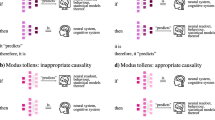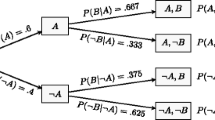Abstract
A fascinating research program in neurophysiology attempts to quantify the amount of information transmitted by single neurons. The claims that emerge from this research raise new philosophical questions about the nature of information. What kind of information is being quantified? Do the resulting quantities describe empirical magnitudes like those found elsewhere in the natural sciences? In this article, it is argued that neural information quantities have a relativisitic character that makes them distinct from the kinds of information typically discussed in the philosophical literature. It is also argued that despite this relativistic character, there are cases in which neural information quantities can be viewed as robustly objective empirical properties.

Similar content being viewed by others
Notes
The entropy associated with a single value of some random variable is given by the log of the reciprocal of its relative frequency. \(\hbox {Log}_{2}(1/.5)\) = 1 bit. \(\hbox {Log}_{2}(1/.25)\) = 2 bits. To find the entropy of an entire distribution, we take a weighted sum over all individual entropies. So, the marginal entropy \(\hbox {H}(\hbox {X}) = .5(1) + .25(2) +.25(2) = 1.5\). The computation required to find the marginal entropy H(Y) is identical to that required for H(X). To compute the joint entropy H(X,Y), we take a weighted sum over the individual entropies associated with each of the six terms in the center of the table. Three of those terms evaluate to 0. Once they are removed, the remaining terms constitute an expression that is identical to that for H(X), which, as we just saw, is equal to 1.5 bits.
It is worth noting here that the hair-in-the-wind argument exploits a perfectly contingent fact about humans. Filiform hairs on the legs of crickets move with the local air currents too. But in that case, neural receiver mechanisms use the hair-air correlation for predator detection (Magal et al. 2006). In that case, hair direction really is an informational signal. At least in principle, the amount of information transmitted in this case could be quantified.
I have not given a definition of the term “function.” As the size of the philosophical literature on the subject suggests, it is not easy to say exactly what it means for an object or process to have a biological function. For many aspects of biological theory, including the kind of function discussed here, I favor the modern history theory of functions, as expressed in Godfrey-Smith (1994). But my view is compatible with other theories of biological function as well. It is important, however, that the notion of function have some relation to natural history. Without that connection, it loses some of the objectivity that I argue is worth retaining in neurophysiological theory. See section “Is neural information cbjective?” for further commentary on this point.
I have suppressed the role of time in this discussion because it complicates the mathematics without changing the conceptual issues under consideration. Notice that the argument doesn’t change significantly if we consider two non-identical strings sent from one location to another over time. If strings share statistical properties, their transmission may achieve the same information rate expressed in bits/s. This is still no reason to think that the two strings have the same meaning.
Another, more controversial, reason to resist the semantic interpretation of information theoretic estimates is that the activity in a single neuron seems to be too low-level for semantic properties to emerge at all. If there are no semantic properties at the level of individual neurons, then, clearly, information estimates describing the behavior of individual neurons cannot be interpreted semantically. Rosa Cao has defended this anti-semantic position on the basis of an interesting dilemma. The signals transmitted by individual neurons either lack sufficiently robust connections to the external world to carry content on their own, or the connections they exhibit are too inflexible too deserve an informational, as opposed to merely causal, mode of description (Cao 2012).
See, for example, Cover and Thomas (1991).
The phrase “For Shannon” in this definition might be misleading. Shannon was many things, but he was not a metaphysician. He was not interested in trying to divide the world into informational phenomena and non-informational phenomena. In fact, in a short paper entitled “The Bandwagon,” Shannon warns that information theory is easily misused when applied outside the realm of communications technology (Shannon 1956).
Although their article is focused on genetic information, they suggest that their definition can be extended to include neural information quantities.
References
Adams F (2003) The informational turn in philosophy. Minds Mach 13(4):471–501
Bar-Hillel Y, Carnap R (1953) Semantic information. Br J Philos Sci 4(14):147–157
Bergstrom CT, Rosvall M (2008) The transmission sense of information. Biol Philos 26(2):191–194
Borst A, Theunissen FE (1999) Information theory and neural coding. Nat Neurosci 2(11):947–957
Cao R (2012) A teleosemantic approach to information in the brain. Biol Philos 27(1):49–71
Cover TM, Thomas JA (1991) Elements of information Theory, 1st edn. Wiley, New York
Dayan P, Abbott LF (2001) Theoretical neuroscience, vol 10. MIT Press, Cambridge
Dretske F (1981) Knowledge and the flow of information. MIT Press, Cambridge
Floridi L (2015) Semantic conceptions of information. In: Zalta EN (ed) The Stanford encyclopedia of philosophy, vol 2015. Spring, Berlin
Frye MA, Dickinson MH (2001) Fly flight: amodel for the neural control of complex behavior. Neuron 32(3):385–388
Gallistel CR, King AP (2009) Memory and the computational Brain: Why cognitive science will transform neuroscience, 1st edn. Wiley, Chichester
Godfrey-Smith P (1994) A modern history theory of functions. Noûs 28(3):344–362
Godfrey-Smith P (2011) Senders, receivers, and genetic information: comments on bergstrom and rosvall. Biol Philos 26(2):177–181
Godfrey-Smith P, Sterelny K (2008) Biological Information. In: Zalta EN (ed) The Stanford Encyclopedia of Philosophy. Fall 2008 edition. https://plato.stanford.edu/archives/fall2008/entries/information-biological/
Harms WF (2006) What is information? Three concepts. Biol Theory 1(3):230–242
Magal C, Dangles O, Caparroy P, Casas J (2006) Hair canopy of cricket sensory system tuned to predator signals. J Theor Biol 241(3):459–466
Neri P (2006) Spatial integration of optic flow signals in fly motion-sensitive neurons. J Neurophysiol 95(3):1608–1619
Piccinini G, Scarantino A (2011) Information processing, computation, and cognition. J Biol Phys 37(1):1–38
Purves D, Augustine GJ, Fitzpatrick D, Katz L, LaMantia A-S, McNamara JO, Williams S (2001) Neuroscience, vol 3. Sinauer Associates, Sunderland
Reiss J, Sprenger J (2014) Scientific objectivity. In: Zalta EN (ed), The Stanford Encyclopedia of Philosophy. Fall 2014 edition. https://plato.stanford.edu/archives/fall2014/entries/scientific-objectivity/
Rieke F, Warland D, Steveninck RDDRV, Bialek W (1999) Spikes: exploring the neural code. A Bradford Book, Cambridge
Sayre K (1976) Cybernetics and the philosophy of mind. Routledge, Abingdon-on-Thames
Shannon CE (1956) The bandwagon. IRE Trans Inf Theory 2(1):3
Shannon CE, Weaver W (1949) The mathematical theory of information. Urbana: University of Illinois Press.
Skyrms B (2010) Signals: evolution, learning, and information. Oxford University Press, Cambridge
Van Hateren J, Kern R, Schwerdtfeger G, Egelhaaf M (2005) Function and coding in the blowfly H1 neuron during naturalistic optic flow. J Neurosci 25(17):4343–4352
Acknowledgements
Funding was provided by the National Science Foundation (Grant No. 1430601). Thanks to Peter Godfrey-Smith, Rosa Cao, Ron Planer, Matteo Colombo, Daniel Kostic, and Gualtiero Piccinini for their insightful criticisms of my initial writings on this topic. Thanks also to two anonymous referees for their detailed commentary on an earlier draft of this manuscript.
Author information
Authors and Affiliations
Corresponding author
Rights and permissions
About this article
Cite this article
Rathkopf, C. Neural information and the problem of objectivity. Biol Philos 32, 321–336 (2017). https://doi.org/10.1007/s10539-017-9561-7
Received:
Accepted:
Published:
Issue Date:
DOI: https://doi.org/10.1007/s10539-017-9561-7




